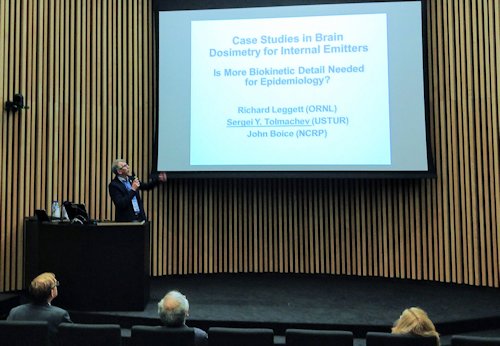12th International Conference on the Health Effects of Incorporated Radionuclides, Fontenay-aux-Roses, France, October 8-11, 2018

Sergei Tolmachev and Maia Avtandilashvili attended the 12th International Conference on Health Effects of Incorporated Radionuclides (HEIR), held in Fontenay-aux-Roses, France on October 8-11, 2018. Dr. Avtandilashvili gave two presentations. The first was an invited lecture on actinide biokinetic researach conducted at the USTUR during the past 50 years, and the second described her work to model the biokinetics of plutonium in a USTUR Registrant who was treated with Ca-DTPA. Dr. Tolmachev also gave two presentations. The first investigated the possibility of improving brain dose estimates for internal emitters by treating the brain as a compartment that is separate from Other tissue. Dr. Tolmachev’s second presentation described the broad range of topics that can be studied using data from USTUR Registrants.
Extended abstracts were submitted for the HEIR conference. An excerpt from each abstract is provided below, and the full abstracts and presentation slides are available for download.
The United States Transuranium and Uranium Registries: Fifty-year history of actinide biokinetic research
Maia Avtandilashvili (USTUR), Stacey L. McComish (USTUR), and Sergei Y. Tolmachev (USTUR)
Designed as a program to improve radiation protection of nuclear workers, the U.S. Transuranium and Uranium Registries (USTUR) studies the biokinetics and internal dosimetry of actinides (uranium, plutonium, and americium) in occupationally exposed Registrants who volunteer portions of their bodies, or their whole bodies, for scientific use posthumously [1]. The USTUR is an invaluable national and international resource for testing biokinetic models and improving the application of bioassay data to estimate tissue doses. [USTUR-0506-18A]
Extended Abstract
Presentation Slides
Case studies in brain dosimetry for internal emitters: Is more detail needed for epidemiology?
Richard W. Leggett (Oak Ridge National Laboratory), Sergei Y. Tolmachev (USTUR), John D. Boice, Jr (NCRP)
Element-specific biokinetic models are used to reconstruct doses to systemic tissues from internal emitters. These models typically depict explicitly only those tissues that tend to dominate the systemic behaviour of the element over time. The remaining tissues are aggregated into a pool called Other tissue in which activity is assumed to be uniformly distributed. Explicitly identified tissues usually consist of some subset of the tissues liver, kidneys, bone, bone marrow, gonads, thyroid, spleen, and skin.
This paper summarizes an assessment of potential improvements in brain dosimetry for internal emitters from explicit modelling of brain kinetics in place of treating the brain as an implicit mass fraction of Other tissue. Comparisons are made of dose coefficients for selected radionuclides based on alternate versions of the systemic biokinetic model for each radionuclide, differing only in the handling of brain tissue. [USTUR-0509-18A]
Extended Abstract
Presentation Slides
Biokinetics of soluble plutonium after wound injury treated with Ca-DTPA
Maia Avtandilashvili (USTUR) and Sergei Y. Tolmachev (USTUR)
The mission of the United States Transuranium and Uranium Registries (USTUR) is to study the uptake, translocation, retention and excretion (biokinetics), and tissue dosimetry of uranium, plutonium, americium, and other actinides in occupationally exposed volunteer Registrants (tissue donors). These individuals were mainly exposed to various types of plutonium material with inhalation and wound as primary routes of intake. The USTUR holds records of exposure history and bioassay measurements, as well as post-mortem tissue radiochemical analysis results for 19 individuals who had documented intakes of 239Pu due to contaminated wounds. For 8 individuals, internal deposition resulted from a single wound injury, and three of them underwent decorporation therapy. In this study, USTUR Case 0303 was used to study biokinetics of soluble Pu after wound intake. [USTUR-0507A-18]
Extended Abstract
Presentation Slides
USTUR: Expanding horizons for actinide biokinetics and dosimetry
Sergei Y. Tolmachev (USTUR), Stacey L. McComish (USTUR), and Maia Avtandilashvili (USTUR)
Since 1968, the U.S. Transuranium and Uranium Registries (USTUR) follows up occupationally-exposed individuals (volunteer Registrants) by studying the biokinetics (deposition, translocation, retention, and excretion) and tissue dosimetry of actinide elements.
The USTUR holds data on work history, radiation exposure and bioassay measurements, as well as medical records from more than 400 former nuclear workers. These individuals had documented intakes of actinides at the levels higher than 74 Bq. Inhalation and wound are two major routes of intake and 239Pu is a primary radionuclide.
Post-mortem radiochemical analyses of tissues obtained at autopsy, especially those from the whole-body donors, allows USTUR significantly improve our knowledge on distribution and long-term retention of actinides in the human body and have helped in parameterizing biokinetic constants for these radioactive elements. [USTUR-0508-18A]